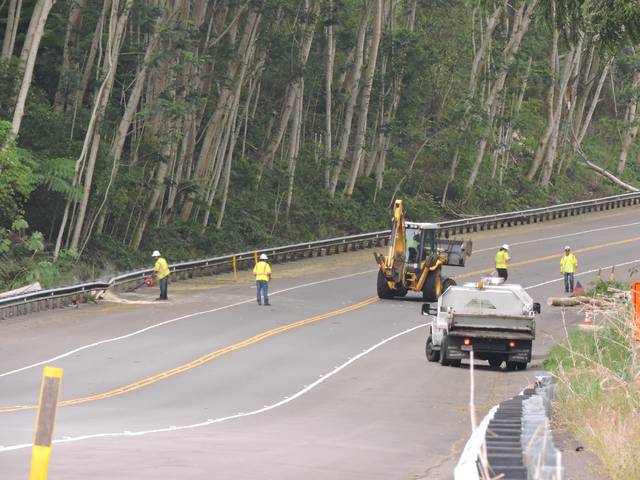Threatening weekend weather caused little damage, offered a quenching drink to thirsty plants in East Hawaii and might have eased the West Hawaii water shortage a bit. ADVERTISING Threatening weekend weather caused little damage, offered a quenching drink to thirsty
Threatening weekend weather caused little damage, offered a quenching drink to thirsty plants in East Hawaii and might have eased the West Hawaii water shortage a bit.
Some areas received heavy downpours, but data from Hilo International Airport showed just less than an inch of rain there for the entire weekend.
According to the National Weather Service in Honolulu, heavy downpours can occur in one spot while a short distance away gets no rain at all. It all depends on factors such as location, forest cover and how far the spot is upslope.
Gusty winds Monday knocked albizia trees down, sending them across Hilo’s Puainako Street extension near Wilder Road, closing lanes in both directions until crews could remove the debris.
The weekend winter storm warning for mountain summits was extended through Monday evening. The storm left snow on the peaks of Mauna Kea and Mauna Loa.
But NWS meteorologist Derek Wroe said the weather system that was stalled over the state had nearly past by Monday afternoon, and it was unlikely much additional snow would fall.
“It’s definitely colder than normal for this time of year,” said Mike Aina, infrastructure supervisor with operations at the W. M. Keck Observatory on Mauna Kea.
Aina, filling in as summit supervisor, said weather can change rapidly.
The supervisor checks weather conditions on an ongoing basis and assesses road conditions and crew safety. Workers can leave within 30 minutes, if necessary, when bad weather approaches, he said.
Aina said the Mauna Kea summit got perhaps 2 to 4 inches of snow during the weekend.
But it was the wind Monday that made for blizzard conditions, with gusts up to 50 mph. The temperature also dipped to 23 degrees.
“That’s cold,” Aina said.
In previous weeks, he said, temperatures outside the observatory have been in the upper 30s and as high as the 50s.
The Mauna Kea weather line reported that the combination of low temperatures and plentiful moisture made “for unsafe road conditions” to the summit Monday. The road was closed to the public from the visitor center at 9,200 feet.
Stewart Hunter, general manager at Mauna Kea Observatories Support Services, said crews were out at 7 a.m. Monday morning clearing the summit road.
Crews start early because if they don’t, ice and snow builds up and makes snow removal more difficult when snow continues throughout the course of days. The road to the summit is always closed when snow plows are clearing snow and ice.
“You can get snow any month,” Wroe said. “But usually it happens in the wet season.” Wet season typically ends in April.
Snow falling as late as May “is pretty rare,” Wroe said. But, he added, “we had snow in July last year.”
A loud thunderstorm that struck Pahoa early Monday morning developed rapidly, Wroe said, but also dissipated quickly. Another similar one developed over South Point but was “already dying” by the time it reached shore.
Wroe said it’s unclear how much Monday’s rain in Kailua-Kona will help ease the water shortage.
“Anything helps,” he said Monday afternoon. “A lot of places around there on the slopes have gotten over an inch of rain this weekend.”
Pahoa received about a half-inch of rain Sunday, according to the NWS, and Saddle Road almost an inch. South Point got three-quarters of an inch Sunday.
A small craft advisory remained in effect for the entire Big Island Monday, as did a flash flood watch.
But Wroe said the weather pattern is reverting to a more typical one, with trade winds and the likelihood of visible sunshine ahead.
Email Jeff Hansel at jhansel@hawaiitribune-herald.com.



